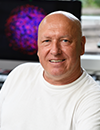|
Session Title: Conference Opening Session |
| |
09:00 |  | Keynote Presentation Strategies For in vitro Perfusion of iPSC-derived Organoids: A Tough Nut to Crack
Roger Kamm, Cecil and Ida Green Distinguished Professor of Biological and Mechanical Engineering, Massachusetts Institute of Technology (MIT), United States of America
Now that organoids can be generated for a variety of organs and tissues
from induced pluripotent stem cells, there is tremendous interest in
developing methods to connect an external perfusion system to an
internal vasculature. Success in this quest would help facilitate
continuous perfusion, leading to improved viability and functionality of
the developing organ, and supporting the introduction of therapeutics
for drug screening and development. For more than 5 years, we have had
the capability to grow self-assembled microvascular beds, or pattern
small vessels within various hydrogels. Methods are also increasingly
available to induce the growth vascular networks inside of the organoid.
To date, however, it has proved challenging to induce anastomosis
between these two networks and enable continuous perfusion. In this
presentation, different methods will be discussed that hold promise to
address this critical problem. |
|
09:45 |  | Keynote Presentation Advanced In vitro Inhalation Lung-on-Chip Platforms For Preclinical Research
Josué Sznitman, Associate Professor, Technion – Israel Institute of Technology, Israel
With rapid advances, the development of lung-on-chip platforms is offering novel avenues for more realistic inhalation assays in pharmaceutical research, and an opportunity to depart from traditional in vitro lung assays. As advanced models capturing the cellular pulmonary make-up at an air-liquid interface (ALI), lung-on-chips emulate both morphological features and biological functionality of the airway barrier with the ability to integrate respiratory breathing motions and ensuing tissue strains. Such in vitro systems allow importantly to mimic more realistic physiological respiratory flow conditions, with the opportunity to integrate physically-relevant transport determinants of aerosol inhalation therapy, i.e. recapitulating the pathway from airborne flight to deposition on the airway lumen. In this presentation, we discuss recent developments in our group on devising such advanced human-relevant lung-on-chip models that mimic in situ-like inhalation assays with endpoints geared at cytotoxicity, respiratory diseases and therapies. |
|
10:30 | Morning Break |
11:00 |  | Keynote Presentation Body on a Chip: A Transformative Approach to Improve Drug Development
Michael Shuler, Samuel B. Eckert Professor of Engineering, Cornell University, President Hesperos, Inc., United States of America
A physiologically representative, multi-organ microphysiological systems
(MPS) based on human tissues (also known as “human-on-a-chip” TM) may
be a transformative technology to improve the selection of drug
candidates most likely to earn regulatory approval from clinical trials.
Such microscale systems combine organized human tissues with the
techniques of microfabrication based on PBPK (Physiologically Based
Pharmacokinetic) models.
I will describe such systems being
constructed at Hesperos and at Cornell. They are “self-contained” in
that they can operate independently and do not require external pumps as
is the case with many other microphysiological systems. They are “low
cost”, in part, because of the simplicity and reliability of operation.
They maintain a ratio of fluid (blood surrogate) to cells that is more
physiologic than in many other in vitro systems allowing the observation
of the effects of not only drugs but their metabolites. While systems
can be sampled to measure the concentrations of drugs, metabolites, or
biomarkers, they also can be interrogated in situ for functional
responses such as electrical activity, force generation, or integrity of
barrier function. Operation up to 28 days has been achieved allowing
observation of both acute and chronic responses with serum free media.
|
|
11:45 |  | Keynote Presentation Intestine on Chip for Normal Physiology and Disease Models
Nancy Allbritton, Frank and Julie Jungers Dean of the College of Engineering and Professor of Bioengineering, University of Washington in Seattle, United States of America
Organ-on-chips are miniaturized devices that arrange living cells to
simulate functional subunits of tissues and organs. These microdevices
provide exquisite control of tissue microenvironment for the
investigation of organ-level physiology and disease. A 3D polarized
epithelium using primary human or mouse gastrointestinal stem cells was
developed to fully recapitulate gastrointestinal epithelial architecture
and physiology. A planar monolayer comprised of stem/proliferative and
differentiated primary cells is cultured on a shaped hydrogel scaffold
with an array of crypt-like structures replicating the intestinal
architecture. Imposition of chemical gradients across the crypt long
axis yields a polarized epithelium with a stem-cell niche and
differentiated cell zone. The stem cells proliferate, migrate and
differentiate along the crypt axis as they do in vivo. A dense mucus
layer is formed on the luminal epithelial surface that is impermeable to
bacteria and acts a barrier to toxins. An oxygen gradient across the
tissue mimic permits luminal culture of anaerobic bacteria while
maintaining an oxygenated stem cell niche. This in vitro human colon
crypt array replicates the architecture, luminal accessibility, tissue
polarity, cell migration, and cellular responses of in vivo intestinal
crypts. A thick impenetrable layer of mucus with biophysical parameters
similar to that of a living human can be formed for epithelial
cell-microbe studies. Intestinal biopsy samples can be used to populate
these constructs to produce patient-specific tissues for personalized
medicine and disease modeling. This bioanalytical platform is envisioned
as a next-generation system for assay of microbiome-behavior,
drug-delivery and toxin-interactions with the intestinal epithelia. |
|
12:30 |  Automated 3D Cell-Based Assays Using a Novel Flowchip System Automated 3D Cell-Based Assays Using a Novel Flowchip System
Evan Cromwell, President & CEO, Protein Fluidics
There is an increasing interest in using three-dimensional (3D) cell structures for modeling tumors, organs, and tissue to accelerate translation research. Significant progress has been made in formation of such structures to recapitulate the in vivo environment but performing complex assays with them can be challenging. Organoids can be subject to loss or damage from pipettes during common steps such as media exchange, supernatant sampling, or immunofluorescence staining. We present here results from automated organoid assays using a Pu·MA System for research in oncology therapeutics, single organoid secretion, and metabolite sampling. The system uses a novel flowchip that contains organoid samples connected to multiple reservoirs via microfluidic channels. Assay reagents are transferred in and out of the sample well without loss of or damage to the organoids. The bottom of the sample chamber is thin optically clear plastic compatible with high resolution fluorescence imaging. The whole system can be kept in an incubator allowing long term cellular assays to be performed. In a first example, effects of anti-cancer drugs on cancer spheroids were assayed using high content imaging. Confocal imaging allowed 3D resolution of spheroid structures and complex analysis of cytotoxic effects. In addition, conditioned media was removed and analyzed for VEGF. In a second example, triple negative breast cancer (TNBC) patient-derived organoids were used for disease modeling. This novel assay system using microfluidics enables automation of 3D cell-based cultures that mimic in vivo conditions, performs multi-dosing protocols and multiple media exchanges, provides gentle and convenient handling of spheroids and organoids, and allows a wide range of assay detection modalities.
|
13:00 | Lunch Break |
|
Session Title: Trends in Organoids and Organs-on-Chip, circa 2021 |
| |
13:30 | Tumor-on-a-Chip Platforms for Analyzing Intact Tumor Biopsies
Albert Folch, Professor of Bioengineering, University of Washington, United States of America
Cancer remains a major healthcare challenge worldwide. It is now well
established that cancer cells constantly interact with fibroblast cells,
endothelial cells, immune cells, signaling molecules, and the
extracellular matrix in the tumor microenvironment (TME). Present tools
to study drug responses and the TME have not kept up with drug testing
needs. Oncology drugs typically take 10 years and cost an average of 1
billion dollars to develop. The number of clinical trials of combination
therapies has been climbing at an unsustainable rate, with 3,362 trials
launched since 2006 to test PD-1/PD-L1-targeted monoclonal antibodies
alone or in combination with other agents. We have developed a
microfluidic platform (called Oncoslice) for the delivery of multiple
drugs with spatiotemporal control to live tumor biopsies, which retain
the TME. We have developed the use of Oncoslice for the delivery of
small-molecule cancer drug panels to glioblastoma (GBM) xenograft slices
as well as to slices from patient tumors (GBM and colorectal liver
metastasis). In addition, we have developed a precision slicing
methodology that allows for producing large numbers of cuboidal
micro-tissues (“cuboids”) from a single tumor biopsy. We have been able
to trap cuboids in arrays of microfluidic traps in a multi-well
platform. This work will potentially allow for the high-throughput
application of drugs to intact human tumor tissues. |
14:00 |  Organoids For Disease Modeling and In Vitro Assessment of Drug Effects by High-Content Imaging and 3D Analysis Organoids For Disease Modeling and In Vitro Assessment of Drug Effects by High-Content Imaging and 3D Analysis
Oksana Sirenko, Sr. Imaging Applications Scientist, Molecular Devices
3D cell models representing different tissues were successfully used for studying complex biological effects, tissue architecture, and functionality. While complexity of 3D models remains a hurdle for the wider adoption in research and drug screening, significant progress has been made in developing tools to automate the culture, monitoring, and analysis of these structures. This enabled an increase in quality of information, throughput, and precision of complex biological assays. We describe automated cell culture and high-content imaging methods that allow monitoring and characterization of growth and differentiation of lung organoids, as well as toxicity and drug effects. Increase in size and complexity of developing organoids was monitored during eight weeks of development. We demonstrated concentration-dependent toxicity effects of several drugs that have been known to cause lung damage. In addition, responses to several anti-cancer drugs were monitored in 3D tumoroids derived from primary tumor tissues. Advanced image analysis allowed 3D reconstitution and complex analysis of organoid structures, characterization of cell morphology and viability, as well as determining expression level of differentiation markers. Image analysis included traditional and Machine Learning-based tools to increase the ability to discern important biological information from the complex multi-dimensional datasets. These quantitative characterization of organoids morphology can be used for studying disease phenotypes and compound effects in complex assay models.
|
14:45 | Mid-Afternoon Break |
15:00 |  | Keynote Presentation Microphysiological Systems as Testbeds Spanning Drug Discovery to Organ Preservation
Kevin Healy, Jan Fandrianto and Selfia Halim Distinguished Professorship in Engineering, University of California, Berkeley, United States of America
Our work has emphasized creating both healthy and diseased model organ systems, called microphysiological systems, to address the costly and inefficient drug discovery process. While organ chips are poised to disrupt the drug development process and significantly reduce the cost of bringing a new drug candidate to market, organ chip technology is much more robust and creates a whole new paradigm in how to study biology, and advances medicine in revolutionary ways. Emerging use of microphysiological systems span organ preservation, biomaterials development, gene editing, and environmental toxicology. This presentation will discuss examples of exploiting microphysiological systems as unique testbeds for these cutting edge areas. |
|
15:45 |  | Keynote Presentation Humanizing Models of Liver Diseases
Linda Griffith, Professor, Massachusetts Institute of Technology (MIT), United States of America
The growing commercial availability of high quality cryopreserved human hepatocytes, expansion of hepatocytes via organoid technology, and advances in derivation of hepatic organoids from iPSC, along with advances in mesofluidic platforms that provide gut-liver interactions, open opportunities for building accessible human disease models. This talk will describe conceptual and technical considerations in building models of liver metabolic and inflammatory diseases, including cell sourcing, culture media design, microphysiological system platform design, incorporation of immune cells, and cross talk with the gut with examples illustrating how to integrate multi-omic data. |
|
16:15 |  Magnetic 3D Cell Culture as an Enabling Tool Magnetic 3D Cell Culture as an Enabling Tool
Glauco Souza, Director of Global Business Development and Innovation, 3D Cell Culture at Greiner Bio-One; Adjunct Assistant Professor, Greiner Bio-One and University of Texas Health Science Center at Houston
The growing push for 3D cell culture models is limited by technical challenges in handling, processing, and scalability to high-throughput applications. To meet these challenges, we use our platform, magnetic 3D cell culture (M3D), in which cells are individually magnetized and assembled with magnetic forces. In magnetizing cells, not only do we make routine cell culture and experiments feasible and scalable, but we also gain control in the formation and manipulation of spheroids and more complex structures. This presentation will focus on recent developments using this platform. Specifically, we will present a tool for manipulating cells and phenotypic profiling of cell types within spheroids. Overall, we apply M3D to improve the development of in vitro microphysiological systems and applications.
|
16:45 |  | Keynote Presentation What Do We Need to Make Microphysiological Systems Drug Assays Massively Parallel?
John Wikswo, Gordon A. Cain University Professor, A.B. Learned Professor of Living State Physics; Founding Director, Vanderbilt Institute for Integrative Biosystems, Vanderbilt University, United States of America
Organs-on-chips, organoids and coupled microphysiological systems (MPS)
will never reach the level of automation possible with single-pass, high
throughput screening of million-compound drug libraries using robots
for acoustic seeding, feeding, and dosing-of cells or spheroids in 1536
well plates, followed by either end-point imaging or acoustic delivery
of media to a mass spectrometer. Nor should they. But one can wonder
exactly how many MPS devices could be created, maintained, and analyzed
by an appropriate robotic perfusion system. We will describe a
convergence of microfluidic, robotic, and analytic technologies that
could easily service a thousand organ-chips or 10,000 separate organoids
in a 42U telecom rack/incubator, each undergoing different
pharmacokinetic exposures and dynamic metabolomic readouts. |
|
17:30 |  YAMAHA CELL HANDLER: Automated, Rapid Spheroid, Organoid and Single Cell Sort System by Imaging and Picking YAMAHA CELL HANDLER: Automated, Rapid Spheroid, Organoid and Single Cell Sort System by Imaging and Picking
Yuichi Hikichi, General Manager, MDB Division , Yamaha Motor
By using various parameters of images, like size, shape and fluorescent intensity, the CELL HANDLERTM can automatically select single cells or 3D spheroids and sort them to various types of culture plates. It uses a unique disposable tip to ensure the damage-free and accurate handling and enables direct picking of organoids from gel. Conventional manual methods have been hampered by low throughput and suboptimal accuracy. Conventional cell sorters damage cells and need significant amounts of cells and are not applicable for spheroids and organoids. The CELL HANDLER complements these deficiencies. It enables more accurate and higher throughput sorting than manual operation and low amounts of cells (e.g. 100-1000 cells) can be sorted without damages. Any types of plates (e.g. microtiter plates, micro cavity plates, 3D colony in gel, 2D colony on plate, organ-on-a-chip) can be used as a source plate and destination plate, which will support many types of applications. The CELL HANDLER is a high-speed, high-precision pick and place system coupled with image capture and analysis capability that greatly increases the efficiency and reliability of spheroid/organoid and single cell assays.
|
18:00 | Close of Day 1 of the Conference |












